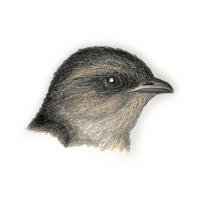 |
Vaux's Swift
Chaetura vauxi |
|
|
STANFORD LOCATIONS: Uncommon and irregular migrant on campus, occasionally seen foraging overhead , often with swallows or White-throated Swifts. |
 |
Location |
Type |
Mating System |
Parental Care |
2ndary Diet |
Strategy |
|
|
|
|
I: 18-20 DAYS ALTRICIAL |
|
|
|
0.6 - 2 feet (TO 20 feet) |
|
(3-7) MONOG |
MF |
| BREEDING: | Forests, esp burned or cutover areas providing snags. ? broods. |
| DISPLAYS: | Courtship and cop performed in flight. Lacks "V-ing" flight display of Chimney Swift. |
| NEST: | Attached to inside wall of hollow tree, occ in chimney, usu near bottom; of twigs or conifer needles glued together and to wall with saliva. |
| EGGS: | White, unmarked. 0.7" (18 mm). |
| DIET: | Flying insects. |
| CONSERVATION: | Winters from c Mexico s to Venezuela. |
| NOTES: | Polygyny reported but frequency unknown. To gather nest materials, birds break off twigs while in flight. Has not commonly accepted chimneys as nest sites. Young fed bolus of food brought by adult, not actually regurgitated. Both parents brood. Young often leave nest at 3 weeks and use sharp, strong claws to cling and crawl on vertical walls. Postbreeding flocks, numbering several hundred, commonly roost together in chimneys. Roosting may be influenced by ambient temperature: birds roost earlier on colder days. |
| ESSAYS: | Feet; Nonvocal Sounds; Migration; Communal Roosting; Temperature Regulation. |
| REFERENCES: | Baldwin and Hunter, 1963; Baldwin and Zaczkowski, 1963. |
| Help | Abbreviations | Species-Alphabetical | Species-Taxonomic | Essays-Alphabetical | |
| Except for Stanford Locations, the material in this species treatment is taken, with permission, from The Birder's Handbook (Paul Ehrlich, David Dobkin, & Darryl Wheye, Simon & Schuster, NY. 1988). | |||||